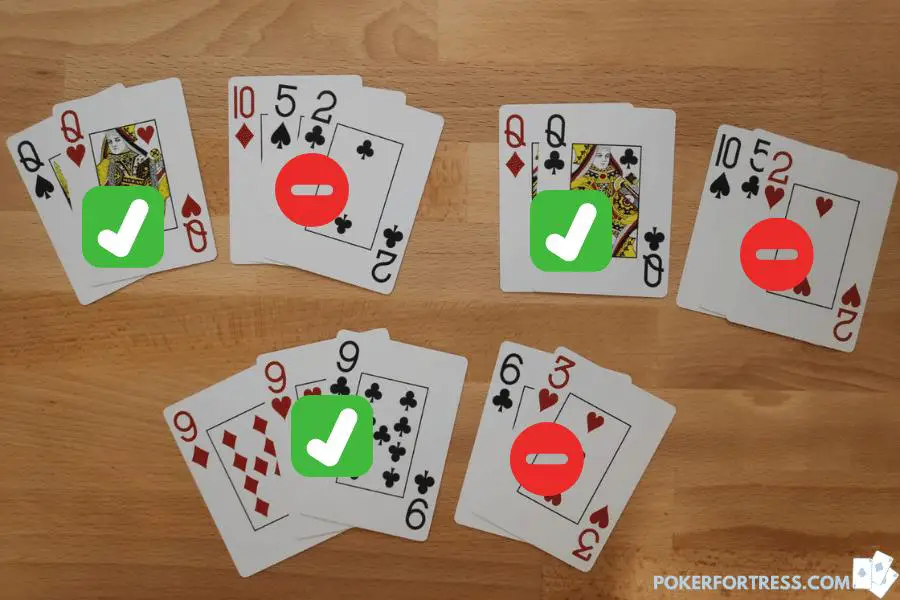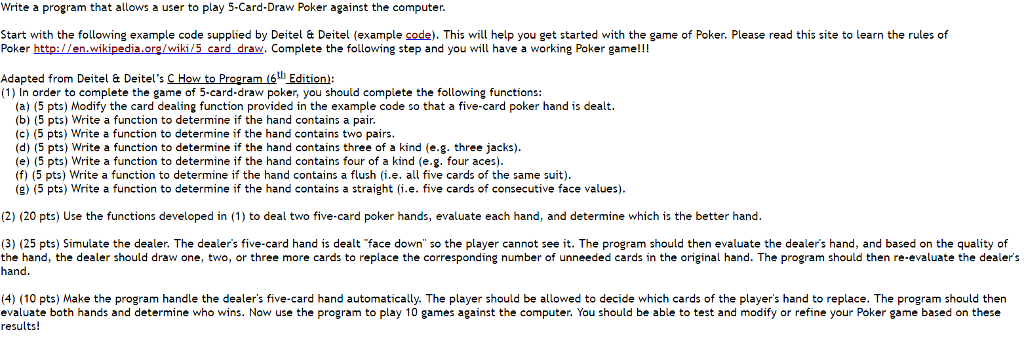5 Card Poker Rules Beginners
5—8 players: Any form of Poker, either Draw or Stud. 9 or 10 players: Five-card Stud Poker. More than 10 players: One of the games in which fewer than five cards are dealt, such as Three-Card Monte or Spit-in-the-Ocean. All of the Poker variations are described later in this chapter. One element used in most poker variants is the system of hand rankings. The highest ranked hand is a Royal Flush (five cards of the same suit, ranked ace through ten), followed by a Straight Flush. Flush - Here, the player gets 5 cards of the same suit, but not in a sequence. For example, you have 3 and 7 of Hearts, and the board has 9,2, and Q of Hearts, then you have a flush.
- Since poker is a five card game it is natural that the earliest form of stud poker was five card stud. In this game each player's first card is dealt face down and known only to the owner, but the other four are dealt face up with a betting round after each.
- Player A/Dealer deals one card at a time, face down, starting on the dealer's left and moves clockwise to Player B, C, D and A until all players have 5 cards. Betting starts with the player to the dealer's left, Player B. They have the option to check or make a wager.
In cash games, the goal is to win money; in tournaments, the goal is to be at the top of the chip leaderboard in order to win the big prizes. They work in a slightly different way, and we’ll go over that later. The aim is the same: to win the pot by getting the best hands at the right time.
To win at poker, you must either bluff your opponents or have the best hand at the end of the game (known as the “showdown”). In poker, the aim is to make the best five-card hand possible. Your hand can contain anything from a single high card to a Royal Flush.

5 Card Draw Poker Rules For Beginners
The Pack in Poker
The regular 52-card deck is used, with one or two jokers thrown in for good measure. While poker is a one-pack game, two packs of contrasting colors are now used in nearly all games played in clubs and among the best players to speed up the game. The other pack is being shuffled and prepared for the next deal when the first is being dealt.
/GettyImages-200381188-009-5a1ecf19beba330037366f50.jpg)
The following is the protocol for two packs: The previous dealer collects all of the cards from the pack he dealt, shuffles them, and puts them to the left while the deal is in progress. The shuffled deck is moved to the next dealer when it’s time for the next contract.
Although Poker can be played in a number of ways, a player who understands the poker hand values and betting principles can play in any form of Poker game with ease. A Poker hand is made up of five cards, except in a few variants of the game. From five of a kind (the best) to no pair or none (the worst), poker hands are ranked as follows:
/SPR_1902822-basic-indoor-orchid-care-5ad7b108ae9ab80038fbe8b5.png)
1) Five of a Kind
This is the best possible hand, and it can only happen in games with at least one wild card, such as a joker, two one-eyed jacks, or four deuces. Four tens and a wild card, or two queens and three wild cards, are examples of five of a kind.
2) Straight Flush
When only the regular pack is used and no wildcards are used, this is the best possible hand. A straight flush is made up of five cards in a row of the same suit, such as the 10, 9, 8, 7, 6 of hearts.
Poker Card Rules Beginners
The A, K, Q, J, and 10 of one suit are the highest-ranking straight flush, and this combination is known as a royal flush or royal straight flush. This side has a 1 in nearly 65 chance of being dealt.
3) Four of a Kind
The next highest hand is a straight flush, and it ranks just below it. Four aces or four threes are two examples. It makes no difference what the unmatched fifth card is.
4) Full House
A full house consists of three cards of one rank and two cards of another rank, such as three 8s and two 4s or three aces and two 6s.
5 Card Poker Rules Beginners Pdf
5) Flush
A flush is five cards of the same suit that are not all in the same order. Q, 10, 7, 6, and 2 of clubs are an example.
6) Straight
A straight is five cards in a row that are not all of the same suit. 9 is an example, as is 8 is an example, 7 is an example, 6 is an example, and 5 is an example of a number.
7) Three of a Kind
This hand consists of three cards of the same rank and two cards of different ranks, such as three jacks, a seven, and a four.
8) Two Pair
This hand includes a pair of one rank and another pair of a different rank, as well as any fifth card of a different rank, such as Q, Q, 7, 7, 4, and so on.
9) One Pair
This common combination consists of just one pair, with the other three cards being of differing ranks. 10, 10, K, 4, 3 is an example.
10) No Pair
This hand includes the word “nothing.” There are no pairs among the five cards, nor are they all of the same suit or rank. When there are no pairs for more than one player.
Since the suits in Poker have no relative rank, two hands that are similar card for card are tied. In this case, the pot is divided between the tied teams. It’s worth remembering that if two hands have the same high pair, the next card in the hands decides which one wins. Consider the following scenario: The score is 9, 9, 7, 4, 2 vs. 9, 9, 5, 3, 2. Similarly, the fifth card will determine between two hands of identical pairs. Consider the following scenario: Q, Q, 6, 6, J wins by a score of Q, Q, 6, 6, 10.
Also Read : How to Play Poker – Easy to Follow Steps Poker Rules
How to Bet In Poker Poker Game Rules for Betting
Poker is basically a game of chip management, so betting is important.

During each Poker contract, the players will have one or more betting intervals where they can bet on their hands. The fundamental skill that Poker necessitates is the ability to reduce losses with bad hands while maximizing winnings with good hands.
Before the cards are dealt, the rules of Poker game will require each player to make an initial deposit, known as a “ante,” of one or more chips into the pot to begin the game.
Each betting interval, or round, begins with a player placing a single or multiple chip bet. Every player to the left must either “call” the bet by putting the same number of chips into the pot; “lift,” which means putting in more than enough chips to call; or “drop” (“fold”), which means putting no chips in the pot, discarding their hand, and exiting the betting until the next offer.
If a player folds, they lose all of their chips in the pot. A player must drop out unless they are able to bring at least as many chips into the pot as the previous player.
When to Place a Bet?
Poker hands are graded according to mathematics. The higher a player’s hand ranks and the more likely it is to win the pot, the less likely he or she is to get it. For instance, a player should not expect to be dealt a straight flush more than once every 65,000 hands, but two pairs should be dealt once every 21 hands.
If a player wants to bluff, he or she does not position a wager without first holding a hand that they believe is the strongest. Without knowing what makes a good hand, a fair hand, and a weak hand, no Poker player can bet intelligently. There is a table with all of the different Poker hands and the number of combinations of each in a pack of cards.
Kitty
The players will build a special fund known as a “kitty” if they agree unanimously or by a majority vote. The kitty is normally made up by “cutting” (taking) one low-denomination chip from each pot with several raises.

The kitty is shared equally by all players and is used to buy new decks of cards as well as food and beverages. Any chips left in the kitty at the end of the game are split evenly among the remaining players. Unlike some other games, such as Pinochle, when a player leaves a Poker game before it finishes, they are not entitled to their share of the chips that make up the pot.
Chips
Almost all poker games are played with poker chips. A supply of at least 200 chips should be available for a game of seven or more players. A red chip (or some other colored chip) is worth five whites, and a blue chip (or some other dark-colored chip) is worth 10 or 20 or 25 whites or two, four, or five reds.
Each player “buys in” to the game by buying a certain number of chips at the start. Usually, all of the players buy in for the same price.
Banker
One player should be known as the banker, who is in charge of keeping track of the stock of chips and documenting how many have been given to each player, as well as how much cash each player has paid for their chips. Players should not conduct private transactions or trades among themselves; a player with extra chips may return them to the banker for credit or cash, while a player in need of more chips can only receive them from the banker.
Conclusion
Each player’s limit is determined by the number of chips in front of them. If a player only has ten chips, he or she can bet no more than ten, and he or she may call every other player’s bet up to that number. No player can remove chips from the table or return chips to the banker before they leave the game in table stakes. A player can add to their stack only between the end of the current deal and the start of the next deal.
Also Read: Learn How to Play Teen Patti Teen Patti Rules